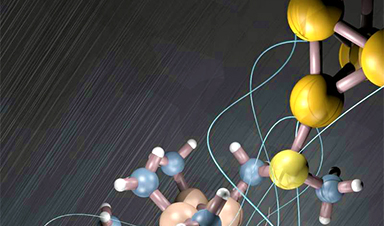Ever shrinking transistors are the key to faster and more efficient computer processing. Since the 1970s, advancements in electronics have largely been driven by the steady pace with which these tiny components have grown simultaneously smaller and more powerful—right down to their current dimensions on the nanometer scale. But recent years have seen this progress plateau, as researchers grapple with whether transistors may have finally hit their size limit. High among the list of hurdles standing in the way of further miniaturization: problems caused by “leakage current.”
Leakage current results when the gap between two metal electrodes narrows to the point that electrons are no longer contained by their barriers, a phenomenon known as quantum mechanical tunnelling. As the gap continues to decrease, this tunnelling conduction increases at an exponentially higher rate, rendering further miniaturization extremely challenging. Scientific consensus has long held that vacuum barriers represent the most effective means to curtail tunnelling, making them the best overall option for insulating transistors. However, even vacuum barriers can allow for some leakage due to quantum tunnelling.
In a highly interdisciplinary collaboration, researchers across Columbia Engineering, Columbia University Department of Chemistry, Shanghai Normal University, and the University of Copenhagen have upended conventional wisdom, synthesizing the first molecule capable of insulating at the nanometer scale more effectively than a vacuum barrier. Their findings are published online today in Nature.
“We’ve reached the point where it’s critical for researchers to develop creative solutions for redesigning insulators. Our molecular strategy represents a new design principle for classic devices, with the potential to support continued miniaturization in the near term,” said Columbia Engineering physicist and co-author Latha Venkataraman, who heads the lab where researcher Haixing Li conducted the project’s experimental work. Molecular synthesis was carried out in the Colin Nuckolls Lab at Columbia’s Department of Chemistry, in partnership with Shengxiong Xiao at Shanghai Normal University.
Image Credit: Haixing Li/Columbia Engineering
News This Week
Lower doses of immunotherapy for skin cancer give better results, study suggests
According to a new study, lower doses of approved immunotherapy for malignant melanoma can give better results against tumors, while reducing side effects. This is reported by researchers at Karolinska Institutet in the Journal of the National [...]
Researchers highlight five pathways through which microplastics can harm the brain
Microplastics could be fueling neurodegenerative diseases like Alzheimer's and Parkinson's, with a new study highlighting five ways microplastics can trigger inflammation and damage in the brain. More than 57 million people live with dementia, [...]
Tiny Metal Nanodots Obliterate Cancer Cells While Largely Sparing Healthy Tissue
Scientists have developed tiny metal-oxide particles that push cancer cells past their stress limits while sparing healthy tissue. An international team led by RMIT University has developed tiny particles called nanodots, crafted from a metallic compound, [...]
Gold Nanoclusters Could Supercharge Quantum Computers
Researchers found that gold “super atoms” can behave like the atoms in top-tier quantum systems—only far easier to scale. These tiny clusters can be customized at the molecular level, offering a powerful, tunable foundation [...]
A single shot of HPV vaccine may be enough to fight cervical cancer, study finds
WASHINGTON -- A single HPV vaccination appears just as effective as two doses at preventing the viral infection that causes cervical cancer, researchers reported Wednesday. HPV, or human papillomavirus, is very common and spread [...]
New technique overcomes technological barrier in 3D brain imaging
Scientists at the Swiss Light Source SLS have succeeded in mapping a piece of brain tissue in 3D at unprecedented resolution using X-rays, non-destructively. The breakthrough overcomes a long-standing technological barrier that had limited [...]
Scientists Uncover Hidden Blood Pattern in Long COVID
Researchers found persistent microclot and NET structures in Long COVID blood that may explain long-lasting symptoms. Researchers examining Long COVID have identified a structural connection between circulating microclots and neutrophil extracellular traps (NETs). The [...]
This Cellular Trick Helps Cancer Spread, but Could Also Stop It
Groups of normal cbiells can sense far into their surroundings, helping explain cancer cell migration. Understanding this ability could lead to new ways to limit tumor spread. The tale of the princess and the [...]
.














Leave A Comment